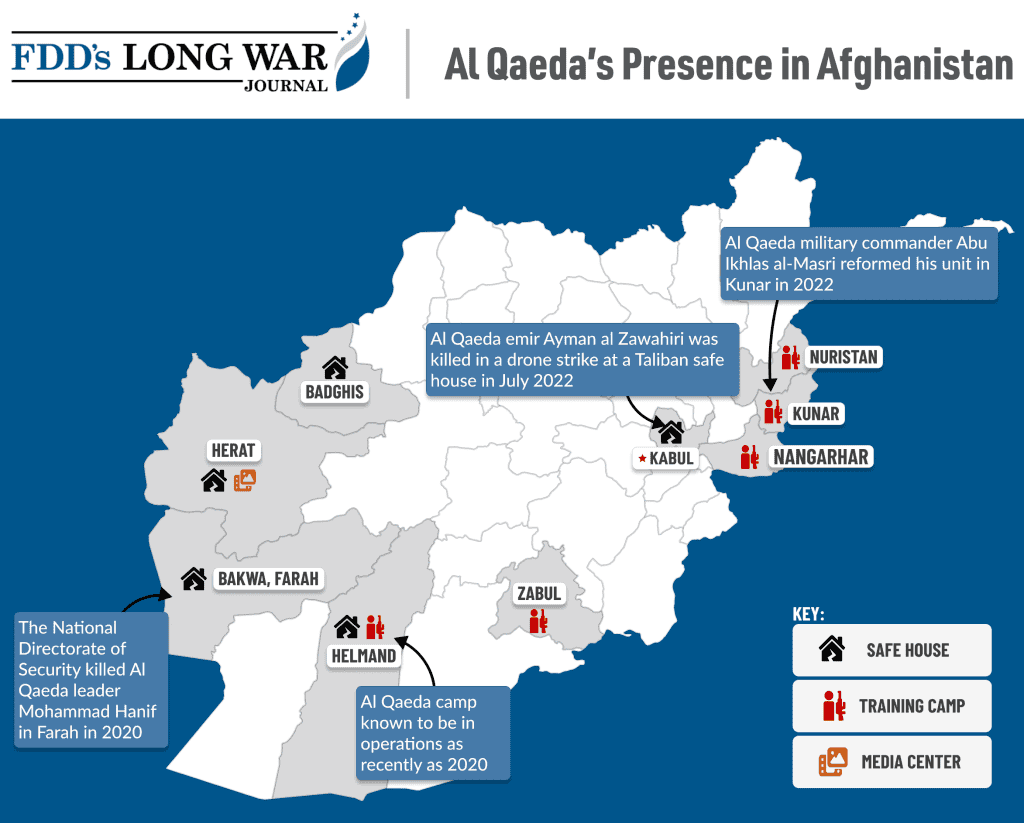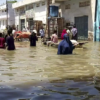BY BILL ROGGIO

On the eve of the 22nd anniversary of Al Qaeda’s deadly attacks on New York and Washington, American intelligence officials further minimized the terror group’s safe haven in Afghanistan and its global reach. The U.S. intelligence community’s assessment that “Al Qaeda is at its historical nadir in Afghanistan and Pakistan, and its revival is unlikely” is directly at odds with intelligence gleaned by the United Nations Analytical Support and Sanctions Monitoring Team, which recently reported that Al Qaeda is running training camps, safe houses, and a media operations center throughout Afghanistan.
The assessment of Al Qaeda in Afghanistan and Pakistan was briefed to reporters on Sept. 8 by two unnamed U.S. intelligence officials. In addition to Al Qaeda being at a “historical nadir,” its “ability to threaten the United States from Afghanistan or Pakistan is probably at its lowest point,” the officials claimed, according to CNN.
Oddly, the intelligence officials surmised that Al Qaeda is weak because the U.S. withdrawal from Afghanistan meant that Al Qaeda fighters no longer had a “proving ground” to battle U.S. forces.
Additionally, the intelligence officials claimed that Al Qaeda “was left without ‘leadership talent’ and “strategic guidance’” after the U.S. killed Al Qaeda emir Ayman al-Zawahiri in a drone strike at a Taliban safe house in Kabul in the summer of 2022, CNN reported.
The intelligence officials dismissed the UN Monitoring Team’s report as “an outlier within the UN system” and “‘wildly out of whack’ with intelligence collected by the US and its partners,” CNN noted.
However, the UN Monitoring Team’s report closely tracks with information on Al Qaeda’s historical and recent operations in Afghanistan that has been gathered by FDD’s Long War Journal.
A Historical Nadir?
The unnamed intelligence officials were incredibly dismissive of the Monitoring Team’s report, which was released in early June. According to the Monitoring Team, the Al Qaeda camps are located in six Afghan provinces: Helmand, Zabul, Badghis, Nangarhar, Nuristan, and Kunar. Additionally, the Monitoring Team noted that Al Qaeda has established “safe houses” in Farah, Helmand, Herat and Kabul, and opened a media operations center in Herat.
Despite the assertions of the U.S. intelligence officials, Al Qaeda was known to have a significant presence in the provinces of Helmand, Farah, Zabul, Kunar, Nuristan, and Nangarhar prior to the U.S. withdrawal from Afghanistan. There is no indication that Al Qaeda abandoned these provinces with post-U.S. withdrawal. As the Monitoring Team has noted and FDD’s Long War Journal has independently assessed, the Taliban-Al Qaeda relationship remains strong.
Helmand province has long been fertile ground for Al Qaeda. In 2015, FDD’s Long War Journal reported that Al Qaeda was operating a training camp in Baramcha in Helmand (the camp in Baramcha was known to be in operation as recently as 2020). Zabul, Kunar, and Nuristan were identified by Osama bin Laden as critical, friendly terrain for Al Qaeda back in 2010, when Osama bin Laden instructed some of Al Qaeda’s leaders to relocate to Zabul, Nuristan, Kunar, and Ghazni provinces in eastern Afghanistan to avoid the U.S. drone campaign in North and South Waziristan. Historically, Al Qaeda has operated training camps in both Kunar and Nuristan, and Zabul (as well as Ghazni) is a traditional Al Qaeda stronghold.
A previous Sanctions and Monitoring Team report noted that Abu Ikhlas al-Masri, a veteran Al Qaeda leader, has reestablished his military unit in Kunar province. Prior to his capture in 2010, al-Masri ran training camps in Kunar, where he served as Al Qaeda’s chief of operations. The training camp in Nuristan is “specifically for the training of suicide bombers,” the Monitoring Team reported. The Taliban’s current governor of Nuristan, Hafiz Muhammad Agha Hakeem, has been identified by the Sanctions and Monitoring Team as an Al Qaeda leader [See LWJ report, Al Qaeda leaders are prominently serving in Taliban government.]
Nangarhar has also been key terrain for Al Qaeda given it close proximity to both the Afghan capital and Pakistan. At the end of 2001, Al Qaeda held out in mountain fortifications against U.S. forces during the battle of Tora Bora in late 2001. Post-Tora Bora, Al Qaeda has utilized Nangarhar as a key node to attack Kabul.
Al Qaeda’s safe house in Kabul was confirmed with the killing of Zawahiri. Al Qaeda is known to have operated a safe house in Farah as recently as late 2020, when the now-disbanded National Directorate of Security killed Mohammad Hanif, a veteran Pakistani jihadist who rose to the highest levels of leadership within Al Qaeda in the Indian Subcontinent, Al Qaeda’s regional branch.
No Proving Ground?
As noted earlier, the idea that Al Qaeda is weakened due to the U.S. withdrawal is odd to say the least. The intelligence officials’ claim that the lack of U.S. forces in Afghanistan has taken away Al Qaeda’s raison d’etre for remaining in the country is not supported by any evidence. This line of reasoning, such as it is, demonstrates a complete lack of understanding Al Qaeda and its strategic goals.
The intelligence officials assume that the only reason Al Qaeda would maintain a fighting force in Afghanistan is to kill American troops and civilians. This couldn’t be further from the truth. Al Qaeda’s mission is to restore an Islamic caliphate by supporting fellow jihadist groups. Period.
Al Qaeda seeks to build its caliphate one emirate at a time. Killing Americans, either in the U.S. homeland or abroad, is merely a tactic Al Qaeda uses to weaken U.S. resolve and force them to quit invading the countries where Al Qaeda is fomenting jihadist insurgencies.
With the Taliban victory in Afghanistan and the reestablishment of the Taliban’s Islamic Emirate of Afghanistan, Al Qaeda now has what the Monitoring team described as “safe haven.” After decades of fighting alongside the Taliban, and at significant cost, Al Qaeda can now regroup, rest, refit and prepare for the next phase of its jihad, while supporting its branches in other theaters. Tucked away in its safe haven of Afghanistan, Al Qaeda now has the time, space and resources to plot attacks against the West if it deems such attacks beneficial to the cause.
Al Qaeda is assisting the Taliban with consolidating its control of Afghanistan. According to the Monitoring Team, in addition to running training camps, Al Qaeda leaders are serving in the Taliban’s government and bureaucracies, while the Taliban is using Al Qaeda’s training manuals in its defense ministry.
However, that isn’t to say that Al Qaeda isn’t active in fighting in Afghanistan to this day. Afghan resistance sources have have told FDD’s Long War Journal that Al Qaeda continues to fight alongside the Taliban against groups like the National Resistance Front as well as the Islamic State, another mortal enemy of the Taliban. Hundreds of Al Qaeda fighters are reported to have participated in the Taliban’s siege and eventual takeover of Panjshir province in Sept. 2021, even though there were no U.S. troops present.
Although it is not reported, it is highly likely that Al Qaeda is fighting inside Pakistan alongside the Movement of the Taliban in Pakistan (TTP), as it has historically. The Monitoring Team reported that both the Afghan Taliban and Al Qaeda are supporting the TTP. Al Qaeda, for its part, “trained and supplied ideological guidance to TTP fighters in suicide bomber training camps in Kunar Province,” the Monitoring Team noted. These camps are likely run by Abu Ihklas al-Masri.
A Dearth of Leadership Talent?
The U.S. intelligence officials also clung to the widely accepted theory that Al Qaeda’s so-called “core” leadership consists of its legacy leaders, and Ayman al Zawahiri was the only core leader left who matters.
This legacy core leader theory is deeply flawed as it assumes that Al Qaeda’s leadership is static over time, and that the group is unable to replace its leaders. Both Zawahiri and bin Laden founded Al Qaeda in 1988. Bin Laden served as Al Qaeda’s emir for 23 years before he was killed in Pakistan in 2011. Zawahiri served as bin Laden’s deputy for 23 years, and led Al Qaeda for another 11 years before he was killed in Kabul in 2022. Al Qaeda has decades to groom a new generation of leaders, even with the attrition experienced by U.S. targeting in multiple theaters.
The U.S. had significant success in targeting Al Qaeda’s historical leadership since 9/11, particularly in Pakistan’s tribal agencies of North and South Waziristan from 2005-2017. However, Al Qaeda adapted to the drone campaign by decentralizing its leadership cadre and relying more heavily on its branches for leadership talent. For instance, Yazid Mebrak, the emir of Al Qaeda in the Islamic Maghreb and Ahmed Diriye, the leader of Al Qaeda East Africa (more commonly known as Shabaab) are in Al Qaeda’s chain of succession. When the U.S. killed Nasir al Wuhayshi, the founder of Al Qaeda in the Arabian Peninsula, in 2015, he also served as the group’s general manager.
This is not to say that veteran Al Qaeda leaders are not present in Afghanistan. Abdul Haq al Turkistani, the leader of the Turkistan Islamic Party who is also a member of Al Qaeda’s leadership council, is known to operate in Afghanistan. Osama Mahmood, the leader of Al Qaeda in the Indian Subcontinent, is esconsed in the country. Amin al Haq, bin Laden’s former security chief, made a triumphant return to Afghanistan from Pakistan soon after the Taliban seized the country. Abu Ikhlas al Masri, a top military commander who was imprisoned at Bagram until the Taliban opened the gates to the jail, has reestablished his military units.
Al Qaeda veteran Saif al Adel, who is said to have succeeded Zawahiri, is reported to have traveled to Afghanistan and may be in the country. Abdal-Rahman al-Maghrebi, a top Al Qaeda leader who is likely Adel’s deputy, is also reported to have traveled to Afghanistan. If Adel and Maghrebi are currently not in Afghanistan, they are in Iran, where they are known to have sheltered and operated with the support of Iran’s intelligence directorate and Islamic Revolutionary Guards Corps. Al Qaeda’s extensive presence in Iran and its leaders’ access to Afghanistan is another significant problem that isn’t addressed by the unnamed intelligence officials.
U.S. intelligence officials and the Biden administration’s continual downplaying of Al Qaeda presence and reach in Afghanistan does not comport with the reality on the ground. Over the past decade and a half, U.S. intelligence officials and policy makers have an abysmal track record in properly assessing Al Qaeda in Afghanistan, as well as the Taliban.
From the assertion that Al Qaeda would melt away in Kunar and Nuristan once U.S. troops left the provinces, to the “50 to 100 Al Qaeda in Afghanistan fallacy,” to claiming the Taliban was moderate and would share power with the now-defunct Afghan government, to claims that the Taliban would “destroy Al Qaeda,” there is no shortage of evidence to prove that assessments from U.S. intelligence officials and policy makers should be taken as little more than a grain of salt.
Bill Roggio is a Senior Fellow at the Foundation for Defense of Democracies and the Editor of FDD’s Long War Journal.
Are you a dedicated reader of FDD’s Long War Journal? Has our research benefitted you or your team over the years? Support our independent reporting and analysis today by considering a one-time or monthly donation. Thanks for reading! You can make a tax-deductible donation here.











